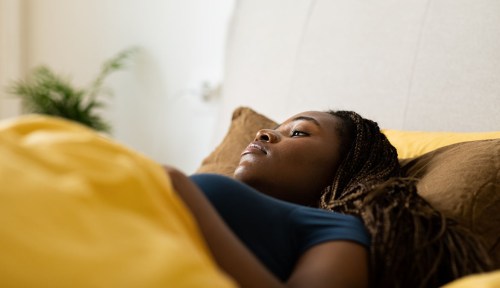Our editors independently select these products. Making a purchase through our links may earn Well+Good a commission
Sleep Experts on the Top Techniques for How to Get to Sleep When It Seems Impossible
How to get to sleep when you can't: Explore effective methods, tips and tricks for falling asleep fast and improving sleep quality.

When you can’t sleep and it’s the middle of the night: there’s truly nothing that seems as urgent as getting back to bed. However, as Rebecca Robbins, PhD, associate scientist at Brigham and Women’s Hospital and instructor in medicine at Harvard Medical School, says, staying in bed when you can’t sleep is the worst thing you can do for your sleep cycle.
Experts in This Article
psychotherapist
assistant professor in medicine at Harvard Medical School and associate scientist at the Brigham and Women’s Hospital
clinical psychologist, sleep specialist, author of The Women’s Guide To Overcoming Insomnia, and Director of Sleep Health at Sleepopolis
licensed psychologist who specializes in therapy for insomnia, CBT-I, sleep issues, anxiety, and depression
“One of the biggest mistakes that many of us make, myself included, is when we’re experiencing sleep difficulty, staying in bed and tossing and turning and thinking that if we just stay in bed a little bit longer, we’ll will ourselves to sleep,” says Dr. Robbins. But we’re actually doing the opposite. “We’re classically conditioning our brains to understand that in bed is where insomnia happens. It’s not a place where we drift off to sleep, but instead where we toss and turn.”
“One of the biggest mistakes that many of us make, myself included, is when we’re experiencing sleep difficulty, staying in bed and tossing and turning and thinking that if we just stay in bed a little bit longer, we’ll will ourselves to sleep.” —Rebecca Robbins, PhD
But what can you do when you’re tossing and turning? A lot, as it turns out. Instead of searching “how to sleep before a big day,” hitting up that online sleep calculator, and just absolutely panicking while glued to your pillow in the dark, there are several methods and techniques for how to get to sleep when you can’t. We spoke to sleep doctors and sleep experts for tried-and-true methods for how to fall asleep fast. Read on (or should we say drift on) ahead.
Techniques for How to Get to Sleep When You Can’t
We get it. It’s 3 AM, you can’t sleep, you’re lying in bed and you need sleep now. Here are a few expert-backed techniques on how to get to sleep when you can’t. And if you’re really in a time crunch, we’ve got techniques on how to fall asleep fast for you as well.
1. Body Scan Meditation
One of the most popular ways to get to sleep when you’re suffering from insomnia is the body scan meditation method. “Close your eyes and focus on each part of your body, starting from your toes and moving up to your head,” says clinical psychologist, Shelby Harris, PsyD, sleep specialist, and Director of Sleep Health at Sleepopolis. Then, “pay attention and take note of any sensations or tensions in each area. This practice can help mask any distracting thoughts that are keeping you up so you can relax your mind and body, making it easier to relax and fall asleep.”
While going through your body, “notice any aches, pains, tensions, or discomfort,” says licensed psychologist Shmaya Krinsky, PsyD. Be careful not to make any judgments about these, he says, and just be aware. “A body scan isn’t about trying to change anything in your body. It’s mainly about just noticing what feels comfortable and uncomfortable, feeling more grounded, and becoming more connected to your body.”
Dr. Krinsky explains that while it seems relaxing (and it is), this is also “a way to train your mind to respond more effectively to stress and make it easier to come out of that fight or flight mode.” Eventually, he says, “you’ll learn how to relax and get better sleep.”
2. Progressive Muscle Relaxation
If you’ve tried body scan meditation but it didn’t work, you can try progressive muscle relaxation, which also has you identify different parts of your body like the above, but with added muscle movement. “Progressive Muscle Relaxation (PMR) is almost like a stretch before bed, where you learn to tense and tighten different areas of the body,” explains Dr. Krinsky. He also notes that if you find that you have migraines or pain in the jaw, neck, and back, PMR may be especially useful for you.
In order to do PMR in bed, “relax your body and take five deep breaths in through your nose and out through your mouth,” Dr. Krinsky says. From there, he says “start by tensing your feet and flexing your toes as hard as you can (without straining).” Hold this for a few seconds and then relax your feet and toes again. Then repeat this working your way up your body, ending at your eyebrows and forehead, “focusing on tensing each body part separately for a few seconds, completely letting the tension go and relaxing.”
Dr. Krinsky recommends doing this and giving yourself 10-20 seconds between each muscle group before moving onto each next muscle group.
3. The Imagery Method
If you’ve ever found that you tend to drift off to sleep easier when you’re actively trying to daydream, this method may be perfect for you. “As you lie in bed, imagine a serene place, like a beach or forest, and try to slowly engage all your senses in the visualization,” says Dr. Harris. Think and visualize as many details you can — like the sights, sounds, and sensations. What are you looking at in your serene place? What’s to the left of you? The right of you? What’s on the horizon? If you close your eyes (in your serene place) what sounds do you hear? Are there birds? Waves? The sound of wind rustling?
“This mental distraction can help with racing thoughts or lingering anxiety from the day, helping you get to sleep by focusing your mind on this soothing imagery instead of anything else that may be keeping you up,” says Dr. Harris.
4. The Military Method
Dr. Harris explains that the military sleep method “is a relaxation technique that claims to help people fall asleep quickly by focusing on relaxing different muscle groups in the body one by one, while taking deep breaths.”
If this is starting to sound like PMR with an added focus on breathing, you’re right. However, this method is often associated with claims that it can help people fall asleep in “two minutes flat,” but as Dr. Harris explains, there’s really no scientific evidence to support that specific claim—although there is evidence that relaxation techniques involved in this method (such as muscle relaxation and deep breathing) can improve sleep quality and quantity. Which leads us to…
5. Controlled Breathing
There are a few different controlled breathing techniques you can try to get to sleep as well. Dr. Harris explains that you can try another technique called the 4-7-8 method, where you inhale for four seconds, hold for seven seconds, and exhale for eight seconds.
Another one of these that’s easy to remember is called box breathing. For this, Dr. Krinsky explains that you inhale through the nose for four seconds, hold the breath for four seconds, and exhale through the mouth for four seconds, and finally hold your breath again for four seconds. So, essentially, four steps of four-counts.
5. Paradoxical Intention
If you could somehow forget about your strong desire to fall asleep, wouldn’t sleep come to you more easily? That’s the reality upon which paradoxical intention is based. This cognitive behavioral therapy technique just asks you to get into bed, leave your eyes open, and focus on staying awake, instead of falling asleep, says Dr. Robbins, which can be helpful if you’ve developed any kind of performance anxiety around sleeping.
As you face your fear directly—that is, not sleeping—the pressure to sleep begins to slowly lessen over time, says Dr. Harris. Without that pressure to sleep, it’s ironically all the more likely that sleep will happen naturally.
To be clear, the goal with paradoxical intention isn’t to do activities or move around your house in an effort to actually stay awake, says Dr. Harris. So, this mental trick isn’t great for anyone who’s super concrete in their thinking, she says. “It’s just about staying in bed and saying to yourself, ‘I’m going to stay awake,’ without doing anything else or looking at any screens.” The more you try to do this one thing, the more likely it is for the opposite to eventually happen by default.
6. The “Cognitive Shuffle” Method
The kind of racing thoughts that tend to crop up pre-sleep can put your brain in an alert, analytical state not conducive to sleep. To shift out of that state, though, you may need a real distraction—one that’s strong enough to draw your attention away from anxious thoughts, but not so stimulating that it keeps you awake just the same. Enter: cognitive shuffling, an imagination technique created by Luc Beaudoin, PhD, an adjunct professor of cognitive science at Simon Fraser University, as part of his development of the mySleepButton app.
You simply think up any random object with at least five letters, like “evergreen.” From there, you’d spell it out in your head, and for each letter of the word, think of as many words as you can that start with that letter. In this case, that would mean starting with “e” and thinking up words like “eggs,” “echo,” “entryway,” and so on.
While you’re doing this, picture a visual of each item. And whenever you can’t think of any more items for a given letter, move onto the next letter, and repeat the process. (If you manage to get through the entire word without drifting off, pick another word, and keep it going.) “The visualization and neutral aspect of this technique can help turn off the analytic, verbal narrative part of the brain that often keeps us up,” says Dr. Harris. And it doesn’t hurt that the imagery involved is also far more interesting than a bunch of sheep.
More Tips for How to Get to Sleep When You Can’t
1. Carve out time in the evening to worry
A mind in overdrive can certainly make sleep harder, no matter if it’s about your jam-packed schedule the next day or even that weird bout of boredom sleep you get from bedtime procrastination (you know, when you wake up absolutely drenched in sweat at 1:45 a.m. because you made the fatal mistake of thinking too much on your couch.)
If worrying in bed is what’s keeping you wired, create time and space to worry while not in bed—so that your brain begins to associate worrying with a separate activity that occurs before sleep. “This just means taking a few moments before bedtime to write down any worries that are on your mind, whether they are small or large,” says Dr. Robbins. You can also write down the tasks or projects that are stressing you out (as a to-do list for the next day), so that they’re less likely to haunt you that night.
Not only does this practice help distance the act of worrying from something you do as you’re trying to sleep, but also, it creates cognitive space between you and your own worries. “The practice of writing them down on paper—instead of allowing them to stay in your mind—can significantly improve your ability to relax and ease off to sleep,” says Dr. Robbins.
2. Get some sunlight as soon as you wake up
Another free and simple tip? “Get some sunlight first thing in the morning,” says psychotherapist Cheryl Groskopf, LMFT, LPCC. “Your body’s internal clock or circadian rhythm relies on natural light to know when to wake up and when to go to sleep. Getting 15–30 minutes of morning sun can ‘reset’ your brain’s schedule,” says Groskopf. Not to mention, she adds, that it’s a great excuse to go outside and get some fresh air before starting your day.
As someone who personally tries to do this, I can highly vouch for better sleep (and a better day in general) when you can step outside for your morning cup of coffee. Must be why that morning Starbucks you grab on the way out the door always tastes way better than the coffee you make at home, right? Right?
3. Optimize Your Bedroom
Yes, comfy pillows are important too, but as Dr. Krinsky explains, optimizing your bedroom is also “about creating a space that considers noise, temperature, and even the allergens in the air.” For noise levels, Dr. Krinsky recommends using earplugs. If you prefer soothing soundscapes to sleep, invest in a white noise machine. As for temperature, he also adds that you might also find that you sleep better if you turn the A/C on higher. “For the best sleep, it’s recommended to keep the temperature between 60 to 67 °F (15.6 to 29 °C),” he says. If you find that a stuffy or runny nose keeps you up, Dr. Krinsky recommends “[investing] in an air purifier unit to help keep your sinuses clear and improve your comfort while sleeping.”
FAQs
What to do if you can’t get to sleep?
If you can’t get to sleep, try some of the techniques above, such as body scan meditation, progressive muscle relaxation, the imagery method, paradoxical intention, or cognitive shuffling. These techniques may help you relax and with time, you may be able to train your body to get to sleep faster.
What to do in bed if you can’t sleep?
If you can’t sleep and you’re already lying in bed, try the body scan meditation or progressive muscle relaxation as both these methods begin with you lying in bed.
How do I turn off my brain so I can go to sleep?
If you can’t turn your brain off to go to sleep, try a technique such as progressive muscle relaxation. You may find that focusing your brain on counting 10–20 seconds for each muscle group may redirect your brain and allow you to sleep.
—reviewed by Angela Holliday-Bell, MD










